coolant level Ram ProMaster City 2017 Owner's Manual
[x] Cancel search | Manufacturer: RAM, Model Year: 2017, Model line: ProMaster City, Model: Ram ProMaster City 2017Pages: 345, PDF Size: 3.25 MB
Page 121 of 345
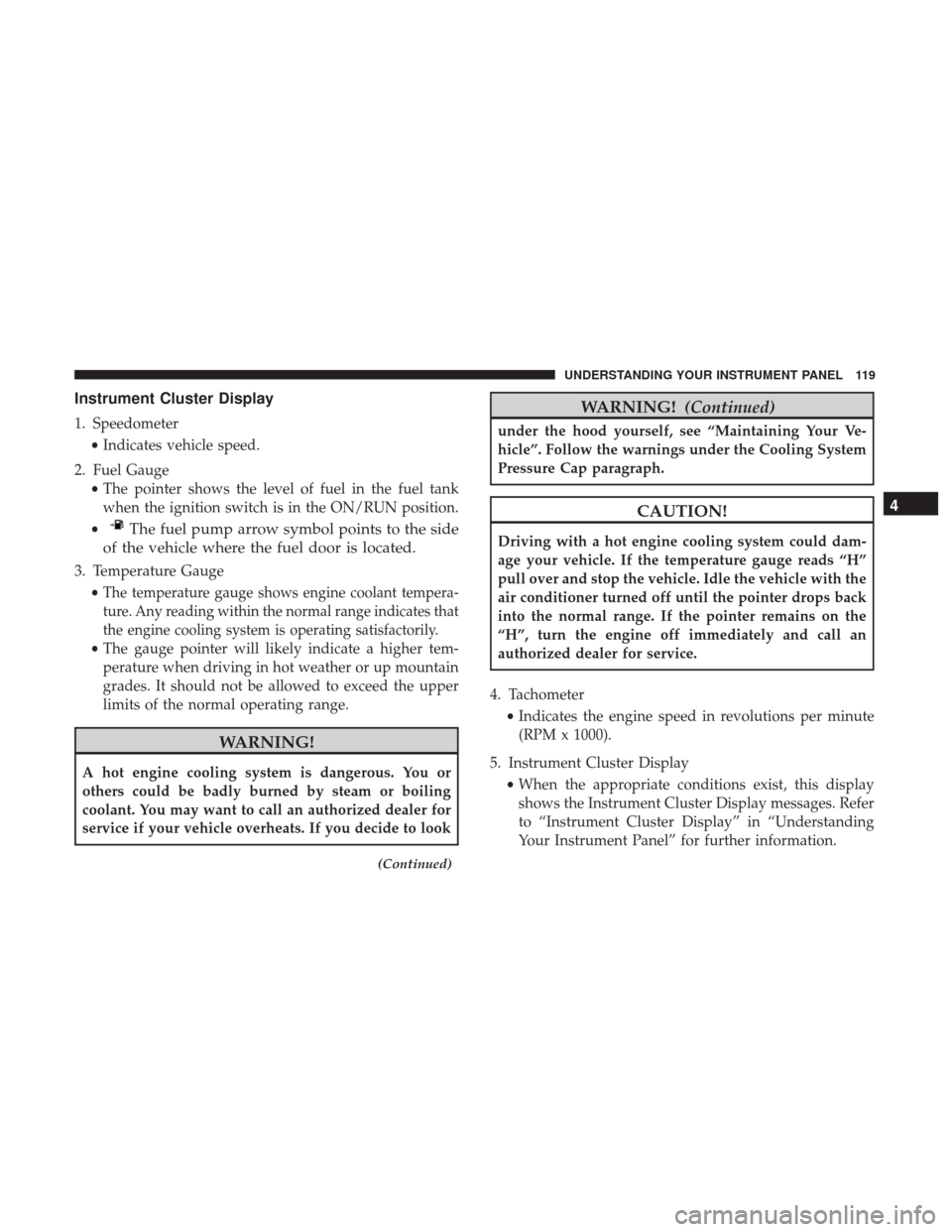
Instrument Cluster Display
1. Speedometer•Indicates vehicle speed.
2. Fuel Gauge •The pointer shows the level of fuel in the fuel tank
when the ignition switch is in the ON/RUN position.
•
The fuel pump arrow symbol points to the side
of the vehicle where the fuel door is located.
3. Temperature Gauge
•
The temperature gauge shows engine coolant tempera-
ture. Any reading within the normal range indicates that
the engine cooling system is operating satisfactorily.
• The gauge pointer will likely indicate a higher tem-
perature when driving in hot weather or up mountain
grades. It should not be allowed to exceed the upper
limits of the normal operating range.
WARNING!
A hot engine cooling system is dangerous. You or
others could be badly burned by steam or boiling
coolant. You may want to call an authorized dealer for
service if your vehicle overheats. If you decide to look
(Continued)
WARNING! (Continued)
under the hood yourself, see “Maintaining Your Ve-
hicle”. Follow the warnings under the Cooling System
Pressure Cap paragraph.
CAUTION!
Driving with a hot engine cooling system could dam-
age your vehicle. If the temperature gauge reads “H”
pull over and stop the vehicle. Idle the vehicle with the
air conditioner turned off until the pointer drops back
into the normal range. If the pointer remains on the
“H”, turn the engine off immediately and call an
authorized dealer for service.
4. Tachometer •Indicates the engine speed in revolutions per minute
(RPM x 1000).
5. Instrument Cluster Display •When the appropriate conditions exist, this display
shows the Instrument Cluster Display messages. Refer
to “Instrument Cluster Display” in “Understanding
Your Instrument Panel” for further information.
4
UNDERSTANDING YOUR INSTRUMENT PANEL 119
Page 132 of 345
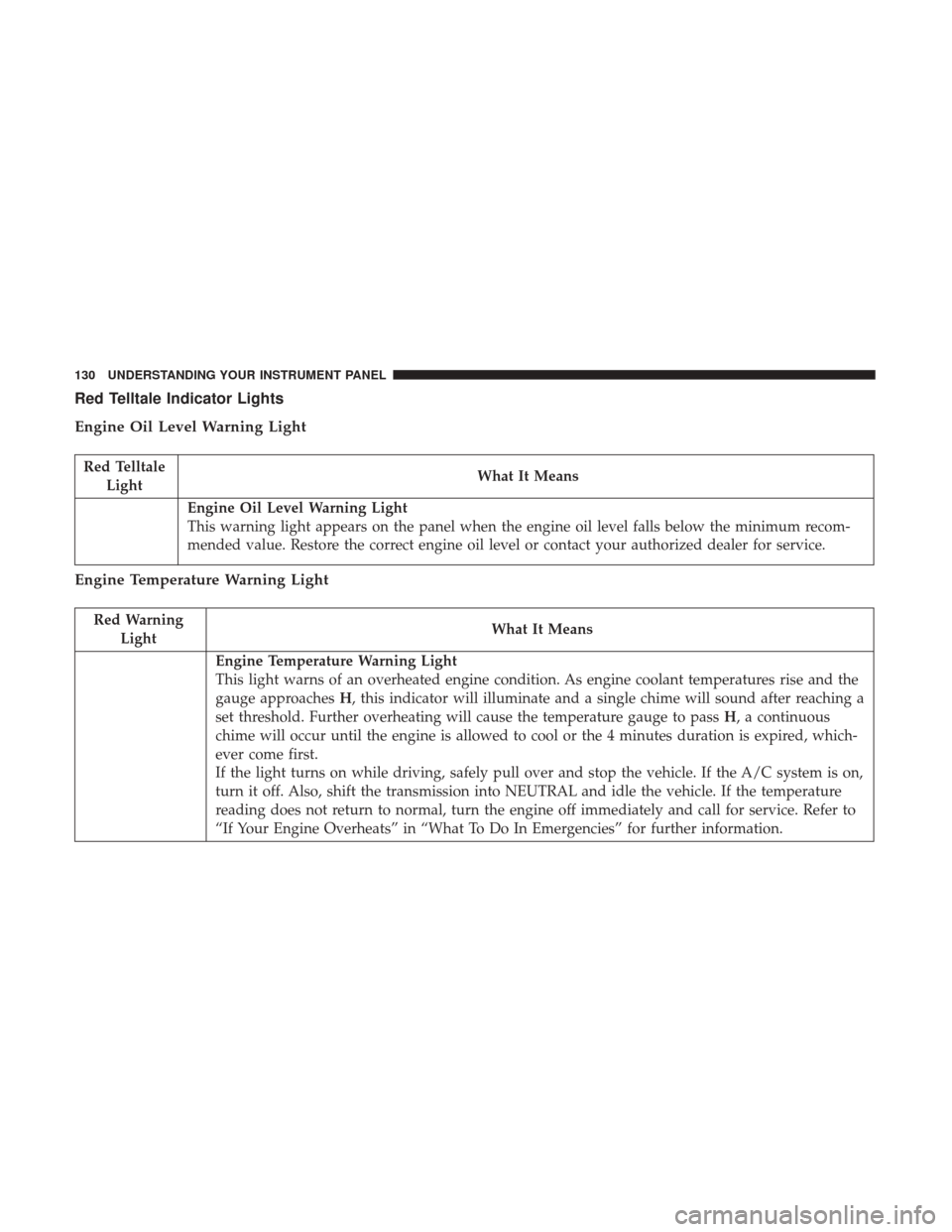
Red Telltale Indicator Lights
Engine Oil Level Warning Light
Red TelltaleLight What It Means
Engine Oil Level Warning Light
This warning light appears on the panel when the engine oil level falls below the minimum recom-
mended value. Restore the correct engine oil level or contact your authorized dealer for service.
Engine Temperature Warning Light
Red Warning
Light What It Means
Engine Temperature Warning Light
This light warns of an overheated engine condition. As engine coolant temperatures rise and the
gauge approaches
H, this indicator will illuminate and a single chime will sound after reaching a
set threshold. Further overheating will cause the temperature gauge to pass H, a continuous
chime will occur until the engine is allowed to cool or the 4 minutes duration is expired, which-
ever come first.
If the light turns on while driving, safely pull over and stop the vehicle. If the A/C system is on,
turn it off. Also, shift the transmission into NEUTRAL and idle the vehicle. If the temperature
reading does not return to normal, turn the engine off immediately and call for service. Refer to
“If Your Engine Overheats” in “What To Do In Emergencies” for further information.
130 UNDERSTANDING YOUR INSTRUMENT PANEL
Page 292 of 345

Adding Coolant
Your vehicle has been built with an improved engine
coolant (OAT coolant conforming to MS.90032) that allows
extended maintenance intervals. This engine coolant (anti-
freeze) can be used up to ten years or 150,000 miles
(240,000 km) before replacement. To prevent reducing this
extended maintenance period, it is important that you use
the same engine coolant (OAT coolant conforming to
MS.90032) throughout the life of your vehicle.
Please review these recommendations for using Organic
Additive Technology (OAT) engine coolant (antifreeze)
that meets the requirements of FCA Material Standard
MS.90032. When adding engine coolant (antifreeze):
•We recommend using MOPAR Antifreeze/Coolant 10
Year/150,000 Mile Formula OAT (Organic Additive
Technology) that meets the requirements of FCA Mate-
rial Standard MS.90032.
• Mix a minimum solution of 50% OAT engine coolant
that meets the requirements of FCA Material Standard
MS.90032 and distilled water. Use higher concentrations
(not to exceed 70%) if temperatures below �34°F (�37°C)
are anticipated. Please contact your authorized dealer
for assistance. •
Use only high purity water such as distilled or deionized
water when mixing the water/engine coolant (anti-
freeze) solution. The use of lower quality water will
reduce the amount of corrosion protection in the engine
cooling system.
NOTE:
• It is the owner’s responsibility to maintain the proper
level of protection against freezing according to the
temperatures occurring in the area where the vehicle is
operated.
• Some vehicles require special tools to add coolant prop-
erly. Failure to fill these systems properly could lead to
severe internal engine damage. If any coolant is needed
to be added to the system, please contact your local
authorized dealer.
• Mixing engine coolant (antifreeze) types is not recom-
mended and can result in cooling system damage. If
HOAT and OAT coolant are mixed in an emergency,
have a authorized dealer drain, flush, and refill with
OAT coolant (conforming to MS.90032) as soon as pos-
sible.
290 MAINTAINING YOUR VEHICLE
Page 293 of 345

Cooling System Pressure Cap
The cap must be fully tightened to prevent loss of engine
coolant (antifreeze), and to ensure that engine coolant
(antifreeze) will return to the radiator from the coolant
recovery tank.
The cap should be inspected and cleaned if there is any
accumulation of foreign material on the sealing surfaces.The image on the coolant system pres-
sure cap is a reminder that the radiator
contains hot engine coolant under pres-
sure.
WARNING!
•Do not open hot engine cooling system. Never add
engine coolant (antifreeze) when the engine is over-
heated. Do not loosen or remove the cap to cool an
overheated engine. Heat causes pressure to build up
in the cooling system. To prevent scalding or injury,
do not remove the pressure cap while the system is
hot or under pressure.
(Continued)
WARNING! (Continued)
•Do not use a pressure cap other than the one speci-
fied for your vehicle. Personal injury or engine
damage may result.
Disposal Of Used Engine Coolant
Used ethylene glycol-based engine coolant (antifreeze) is a
regulated substance requiring proper disposal. Check with
your local authorities to determine the disposal rules for
your community. To prevent ingestion by animals or
children, do not store ethylene glycol-based engine coolant
in open containers or allow it to remain in puddles on the
ground. If ingested by a child or pet, seek emergency
assistance immediately. Clean up any ground spills imme-
diately.
Coolant Level
The coolant expansion bottle provides a quick visual
method for determining that the coolant level is adequate.
With the engine OFF and cold, the level of the engine
coolant (antifreeze) in the bottle should be between the
“MIN” and “MAX” marks.
7
MAINTAINING YOUR VEHICLE 291
Page 294 of 345
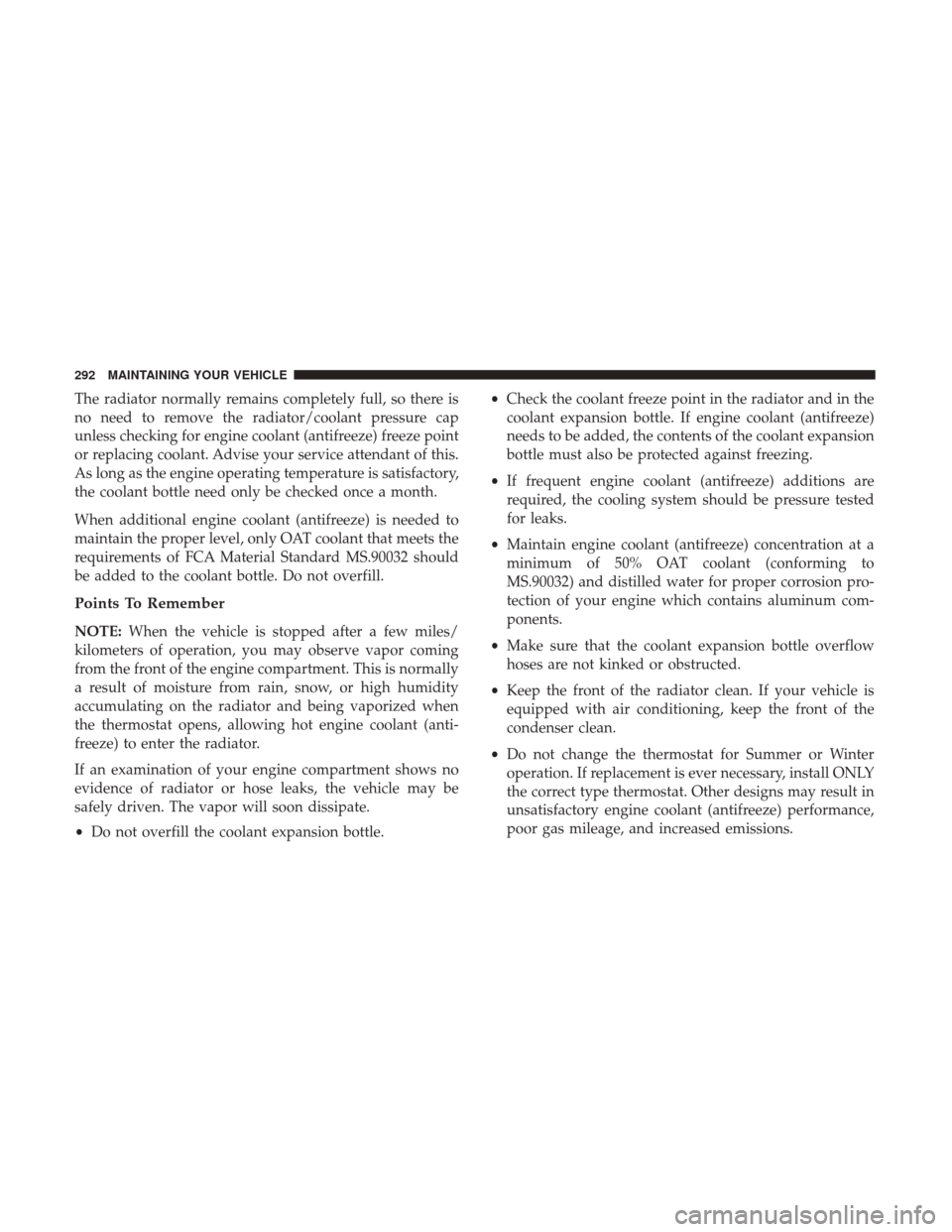
The radiator normally remains completely full, so there is
no need to remove the radiator/coolant pressure cap
unless checking for engine coolant (antifreeze) freeze point
or replacing coolant. Advise your service attendant of this.
As long as the engine operating temperature is satisfactory,
the coolant bottle need only be checked once a month.
When additional engine coolant (antifreeze) is needed to
maintain the proper level, only OAT coolant that meets the
requirements of FCA Material Standard MS.90032 should
be added to the coolant bottle. Do not overfill.
Points To Remember
NOTE:When the vehicle is stopped after a few miles/
kilometers of operation, you may observe vapor coming
from the front of the engine compartment. This is normally
a result of moisture from rain, snow, or high humidity
accumulating on the radiator and being vaporized when
the thermostat opens, allowing hot engine coolant (anti-
freeze) to enter the radiator.
If an examination of your engine compartment shows no
evidence of radiator or hose leaks, the vehicle may be
safely driven. The vapor will soon dissipate.
• Do not overfill the coolant expansion bottle. •
Check the coolant freeze point in the radiator and in the
coolant expansion bottle. If engine coolant (antifreeze)
needs to be added, the contents of the coolant expansion
bottle must also be protected against freezing.
• If frequent engine coolant (antifreeze) additions are
required, the cooling system should be pressure tested
for leaks.
• Maintain engine coolant (antifreeze) concentration at a
minimum of 50% OAT coolant (conforming to
MS.90032) and distilled water for proper corrosion pro-
tection of your engine which contains aluminum com-
ponents.
• Make sure that the coolant expansion bottle overflow
hoses are not kinked or obstructed.
• Keep the front of the radiator clean. If your vehicle is
equipped with air conditioning, keep the front of the
condenser clean.
• Do not change the thermostat for Summer or Winter
operation. If replacement is ever necessary, install ONLY
the correct type thermostat. Other designs may result in
unsatisfactory engine coolant (antifreeze) performance,
poor gas mileage, and increased emissions.
292 MAINTAINING YOUR VEHICLE
Page 315 of 345
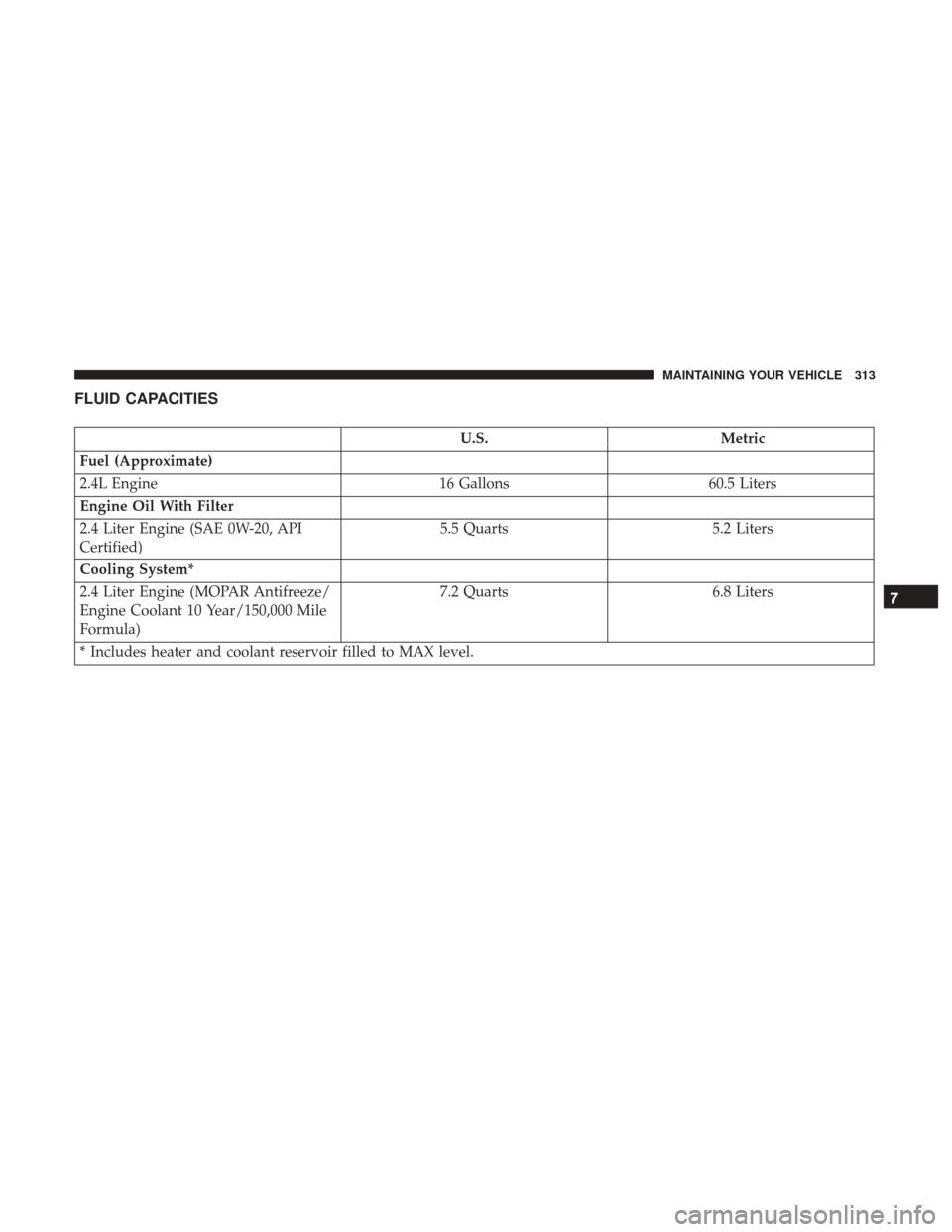
FLUID CAPACITIES
U.S.Metric
Fuel (Approximate)
2.4L Engine 16 Gallons60.5 Liters
Engine Oil With Filter
2.4 Liter Engine (SAE 0W-20, API
Certified) 5.5 Quarts
5.2 Liters
Cooling System*
2.4 Liter Engine (MOPAR Antifreeze/
Engine Coolant 10 Year/150,000 Mile
Formula) 7.2 Quarts
6.8 Liters
* Includes heater and coolant reservoir filled to MAX level.
7
MAINTAINING YOUR VEHICLE 313
Page 321 of 345
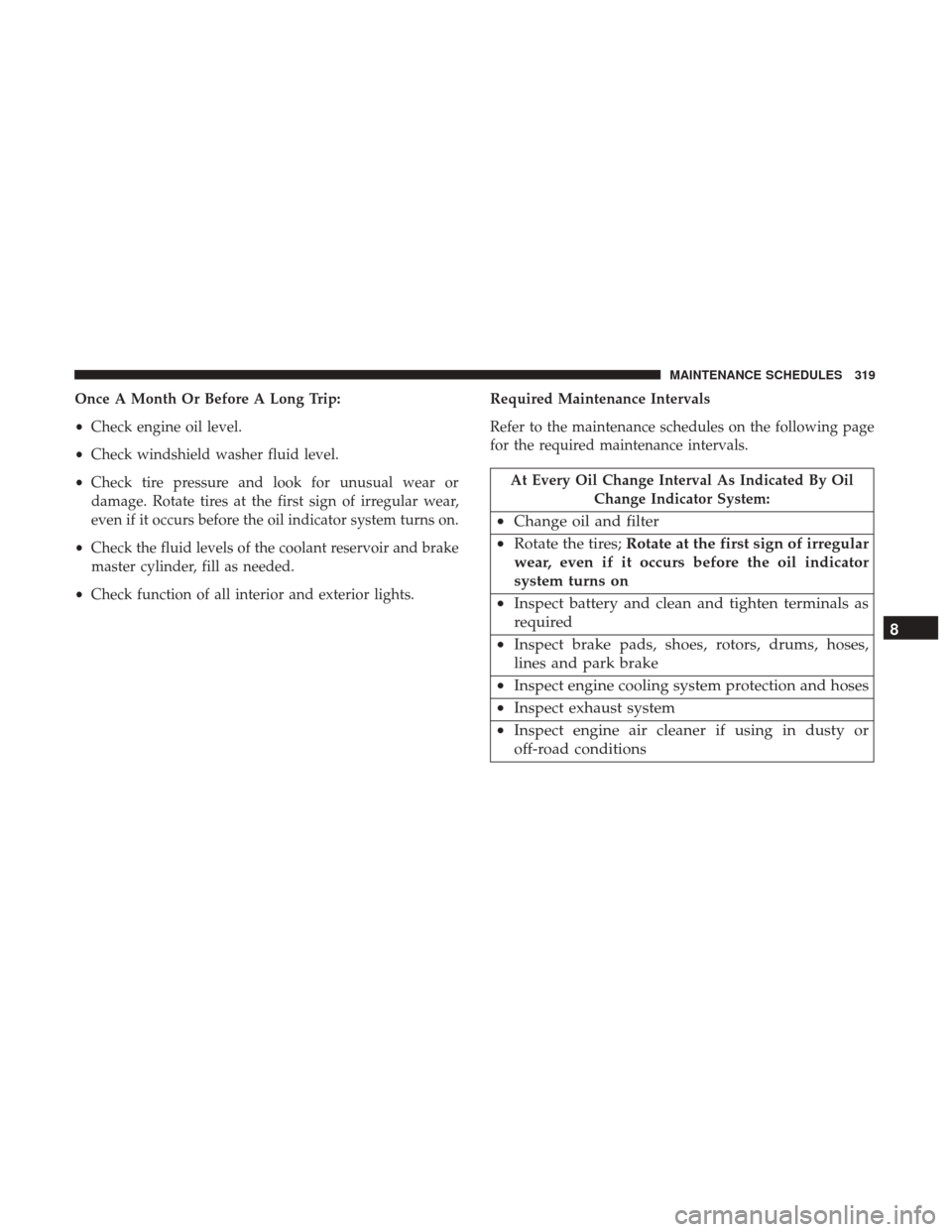
Once A Month Or Before A Long Trip:
•Check engine oil level.
• Check windshield washer fluid level.
• Check tire pressure and look for unusual wear or
damage. Rotate tires at the first sign of irregular wear,
even if it occurs before the oil indicator system turns on.
• Check the fluid levels of the coolant reservoir and brake
master cylinder, fill as needed.
• Check function of all interior and exterior lights. Required Maintenance Intervals
Refer to the maintenance schedules on the following page
for the required maintenance intervals.
At Every Oil Change Interval As Indicated By Oil
Change Indicator System:
•Change oil and filter
• Rotate the tires; Rotate at the first sign of irregular
wear, even if it occurs before the oil indicator
system turns on
• Inspect battery and clean and tighten terminals as
required
• Inspect brake pads, shoes, rotors, drums, hoses,
lines and park brake
• Inspect engine cooling system protection and hoses
• Inspect exhaust system
• Inspect engine air cleaner if using in dusty or
off-road conditions 8
MAINTENANCE SCHEDULES 319
Page 332 of 345
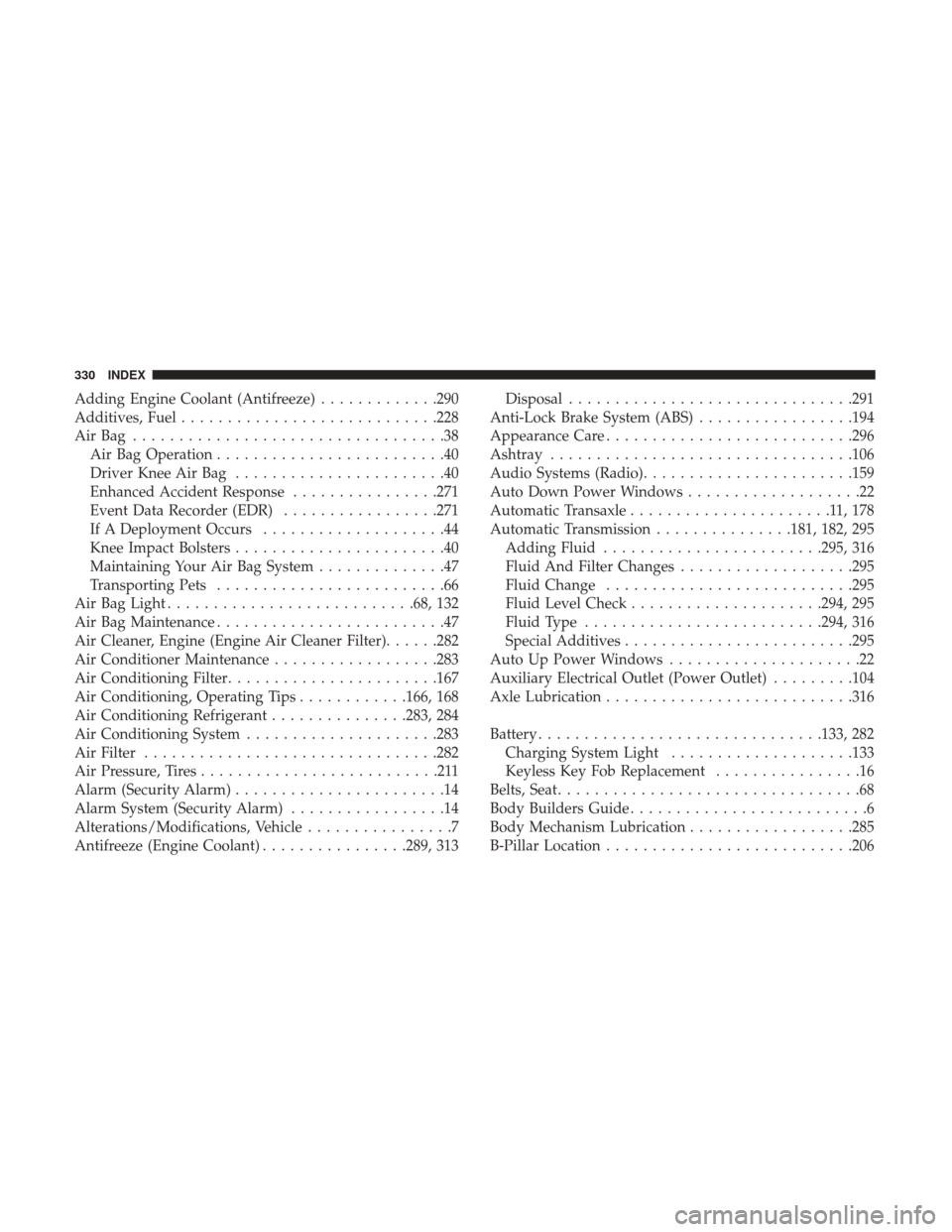
Adding Engine Coolant (Antifreeze).............290
Additives, Fuel ........................... .228
AirBag ..................................38 Air Bag Operation .........................40
Driver Knee Air Bag .......................40
Enhanced Accident Response ................271
Event Data Recorder (EDR) .................271
If A Deployment Occurs ....................44
Knee Impact Bolsters .......................40
Maintaining Your Air Bag System ..............47
Transporting Pets .........................66
Air Bag Light .......................... .68, 132
Air Bag Maintenance .........................47
Air Cleaner, Engine (Engine Air Cleaner Filter) ......282
Air Conditioner Maintenance ..................283
Air Conditioning Filter ...................... .167
Air Conditioning, Operating Tips ............166, 168
Air Conditioning Refrigerant ...............283, 284
Air Conditioning System .....................283
Air Filter ............................... .282
Air Pressure, Tires ..........................211
Alarm (Security Alarm) .......................14
Alarm System (Security Alarm) .................14
Alterations/Modifications, Vehicle ................7
Antifreeze (Engine Coolant) ................289, 313 Disposal
.............................. .291
Anti-Lock Brake System (ABS) .................194
Appearance Care .......................... .296
Ashtray ................................ .106
Audio Systems (Radio) ...................... .159
Auto Down Power Windows ...................22
Automatic Transaxle ......................11,178
Automatic Transmission ...............181, 182, 295
Adding Fluid ....................... .295, 316
Fluid And Filter Changes ...................295
Fluid Change .......................... .295
Fluid Level Check .....................294, 295
Fluid Type ......................... .294, 316
Special Additives ........................ .295
Auto
Up Power Windows .....................22
Auxiliary Electrical Outlet (Power Outlet) .........104
Axle Lubrication .......................... .316
Battery .............................. .133, 282
Charging System Light ....................133
Keyless Key Fob Replacement ................16
Belts, Seat .................................68
Body Builders Guide ..........................6
Body Mechanism Lubrication ..................285
B-Pillar Location .......................... .206
330 INDEX
Page 334 of 345
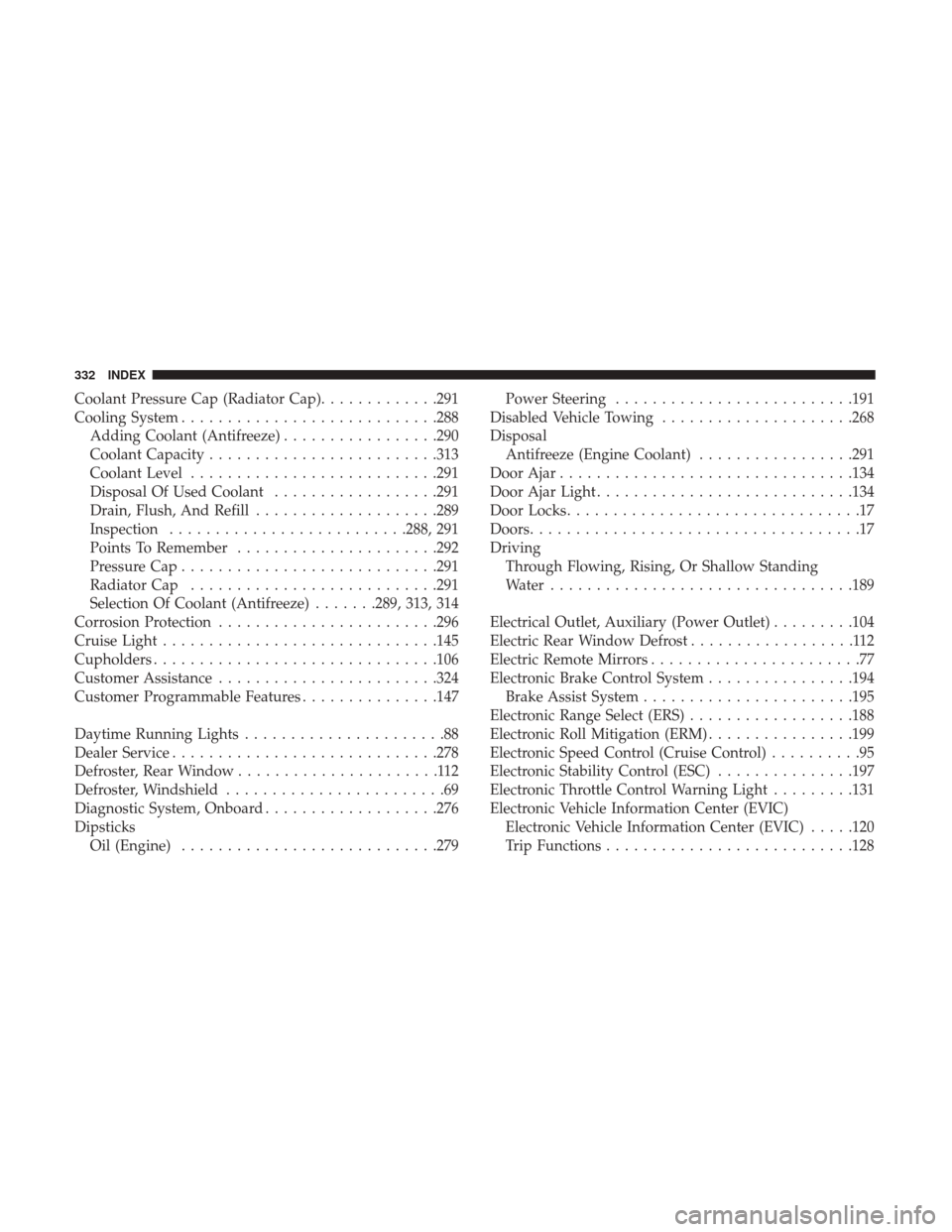
Coolant Pressure Cap (Radiator Cap).............291
Cooling System ........................... .288
Adding Coolant (Antifreeze) .................290
Coolant Capacity ........................ .313
Coolant Level .......................... .291
Disposal Of Used Coolant ..................291
Drain, Flush, And Refill ....................289
Inspection ......................... .288, 291
Points To Remember ..................... .292
Pressure Cap ........................... .291
Radiator Cap .......................... .291
Selection Of Coolant (Antifreeze) .......289, 313, 314
Corrosion Protection ....................... .296
Cruise Light ............................. .145
Cupholders .............................. .106
Customer Assistance ....................... .324
Customer Programmable Features ...............147
Daytime Running Lights ......................88
Dealer Service ............................ .278
Defroster, Rear Window ......................112
Defroster, Windshield ........................69
Diagnostic System, Onboard ...................276
Dipsticks Oil (Engine) ........................... .279Power Steering
......................... .191
Disabled Vehicle Towing .....................268
Disposal Antifreeze (Engine Coolant) .................291
Door Ajar ............................... .134
Door Ajar Light ........................... .134
Door Locks ................................17
Doors ....................................17
Driving Through Flowing, Rising, Or Shallow Standing
Water ................................ .189
Electrical Outlet, Auxiliary (Power Outlet) .........104
Electric Rear Window Defrost ..................112
Electric Remote Mirrors .......................77
Electronic Brake Control System ................194
Brake Assist System ...................... .195
Electr
onic Range Select (ERS)..................188
Electronic Roll Mitigation (ERM) ................199
Electronic Speed Control (Cruise Control) ..........95
Electronic Stability Control (ESC) ...............197
Electronic Throttle Control Warning Light .........131
Electronic Vehicle Information Center (EVIC) Electronic Vehicle Information Center (EVIC) .....120
Trip Functions .......................... .128
332 INDEX
Page 335 of 345

Emergency, In Case OfFreeing Vehicle When Stuck .................266
Jump Starting .......................... .263
Towing ............................... .268
Emission Control System Maintenance ............277
Engine ................................. .275
Air Cleaner ............................ .282
Block Heater ........................... .180
Break-In Recommendations ..................66
Checking Oil Level ...................... .279
Coolant (Antifreeze) ..................... .314
Cooling .............................. .288
Exhaust Gas Caution ...................68, 229
Fails To Start ........................... .179
Flooded, Starting ........................ .179
Fuel Requirements ....................... .226
Jump Starting .......................... .263
Oil ........................... .279, 313, 314
Oil Filler Cap ....................... .275, 281
Oil Filter .............................. .282
Oil Selection ........................ .280, 313
Oil Synthetic ........................... .281
Overheating ........................... .244
Starting .............................. .178
Engine Oil Viscosity ........................ .281Engine Oil Viscosity Chart
....................281
Enhanced Accident Response Feature ............271
Ethanol ................................. .226
Exhaust Gas Caution .....................68, 229
Exhaust System ........................ .68, 286
Exterior Lights .............................71
Filters Air Cleaner ............................ .282
Air Conditioning ........................ .167
Engine Oil ......................... .282, 314
Engine Oil Disposal ...................... .281
Flashers Hazar
d Warning ........................ .244
Turn Signal ......................... .71, 144
Flash-To-Pass ..............................88
Flooded Engine Starting ..................... .179
Fluid, Brake ............................. .316
Fluid Capacities ........................... .313
Fluid Leaks ...............................71
Fluid Level Checks Brake ................................ .293
Engine Oil ............................ .279
Power Steering ......................... .191
Fluids, Lubricants And Genuine Parts ............314
10
INDEX 333